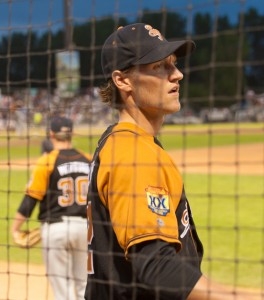
How differently we experience of professional sports than our grandparents’ and great-grandparents’ did. A delightful exhibit at the Boston Public Library on Boston Sports Temples (BPL Main Branch in Copley Square through May 31) makes the point.
In crowd scenes from Red Sox and Braves games in the 1910s and 1920s, hats top every head. None has a ‘B’ on it.
It is difficult – impossible? – to find a woman’s hat. Like the athletes they came to watch, the spectators were uniformed and uniformly male – and white. They dressed as for the office.
Ostensibly, the BPL’s exhibit centers on buildings. But it’s really about the people who filled them and the closeness of the athletes to them.
Even the largest setting – Braves Field seating 45,000 – is intimate. As late as the 1910s, fans stood on the warning track.
A surprisingly large number of venues still exist in recognisable form. A portion of Braves Field survives as Boston University’s Nickerson Field.
Yes, the Boston Garden disappeared in favor of the This-Could-Be-Anywhere Bank Center/Garden. But its predecessor, the Boston Arena, now over 100 years old, flourishes as Northeastern University’s Matthews Arena.
Matthews’s two layers of seats almost on top of the ice suggests a closeness to helmetless heroes our generation hasn’t experienced. Its staircases and sightlines preserve those of the Boston Garden. All that’s missing from the final moments of a basketball game is a pall of tobacco smoke refracting the bright lights.
Because the BPL has chosen to focus on professional sports – a logical choice – it omits a college football venue for a time 25% larger than Braves Field: Harvard Stadium. Football hardly figures in the story of Boston’s professional sports before 1960. The five-year-old Boston Braves/Redskins left for Washington in 1937.
Only Chicago, perhaps, can approach the wealth of ‘sports temples’ of the turn of the 20th century that Boston has. And three of them – Fenway Park, Matthews Arena and Harvard Stadium – are recognisable for what they were.
Hints of other venues remain. Just west of Harvard Stadium, the odd shaped park along the Charles River’s south bank hints at the Charles River Speedway that ran for a mile. Bicycles, sulkies and chariots(!) raced there.
The BPL makes maximal use of scarce space by mounting photo shows on monitors mounted in front of murals. These shows are well-selected. I would have wished them longer, but for most visitors, four or five minutes at each monitor will suffice.
The bulk of the photos come from the more than 35,000 images taken by Leslie Jones during the first five and a half decades of the last century. Two years ago, the BPL began publishing Jones’s baseball pictures.
It is a thrill to learn the journeyman newspaper photographer brought the same gifts to Suffolk Downs. He had a great eye for art in the ordinary.
Sometimes, I wished for more detail in the captions. A fine shot of two teenage brothers, jockeys from Nebraska, notes that one won the 1936 Derby on Bold Venture (the fixture’s most aptly named victor) but neglects to mention the other brother made the Racing Hall of Fame as a trainer largely on Kelso’s career (1960-66).
Even if your interest in sports is non-existent, Jones’s artistry makes a trip to Copley Square worthwhile. My favorite: A line of Suffolk Downs bettors, just after WW II waiting to cash $2 tickets, the last of whom looks like every primary schooler’s nightmare teacher.
Jones’s picture of Rin Tin Tin visiting a Thoroughbred’s stall at Suffolk Downs reminded me of how much space newspapers once had to fill every day.
One mural has no monitor in front of it. It shows a group of young men, amateur ballplayers, about 1900. From across the lobby, one can see a couple with faces ‘like the map of Ireland’. Close up, the dozen or so faces suggest how many counties Ireland has.
The ballplayers represented ‘3rd Base, Your Last Stop Before Home’, a bar on Columbus Avenue owned by one of Boston’s great characters, Michael T. “Nuf Ced” McGreevey.
McGreevey led ‘the Royal Rooters’, a legion of rabid Red Sox fans. Their band, songs and hijinks (bordering on criminal mischief) seem like English football lads rather than today’s Red Sox NESN Nation.
A jockey-sized man, black Irish, with a thick mustache drooping to his chin, McGreevey had a personality that could rule the unruly with his trade-mark, argument-ending: ‘Nuf Ced’!
His 3rd Base, his band and his Royal Rooters disappeared from Boston, with Babe Ruth, on Prohibition’s arrival in 1918. ‘The Last Stop Before Home’ McGreevy leased to the BPL for a branch, and the pictures that covered its walls and the season passes the Red Sox issued him, he gave to the Library.
Much as I loved the entire exhibit, much as I admire Leslie Jones’s skill, it’s to the corner devoted to Michael McGreevey and his friends that my mind keeps returning.
Under those masses of hats were real people, the people who gave this wonderful city its life and character – and made the BPL the institution it is. Nuf Ced!
H/T: In researching this piece, I discovered more fascinating articles – well written, well researched – than I could have imagined. I’ve linked to the best of them, but there are so many more.
Recent Comments